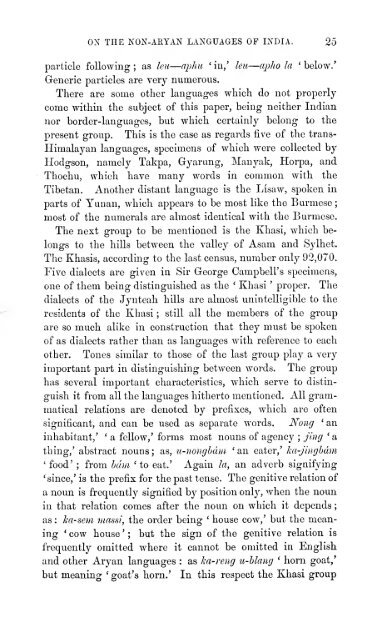Create successful ePaper yourself
Turn your PDF publications into a flip-book with our unique Google optimized e-Paper software.
ox THE NON-ARYAN LANGUAGES OF INDIA. 25<br />
particle following ; as leu— aphii ' in,' leu— ai^ho la ' below.*<br />
Generic particles are very numerous.<br />
There are some o<strong>the</strong>r <strong>languages</strong> which do not properlycome<br />
within <strong>the</strong> subject <strong>of</strong> this paper, being nei<strong>the</strong>r <strong>India</strong>n<br />
nor border-<strong>languages</strong>, but which certainly belong to <strong>the</strong><br />
present group. This is <strong>the</strong> case as regards five <strong>of</strong> <strong>the</strong> trans-<br />
Himalayan <strong>languages</strong>, specimens <strong>of</strong> which were collected by<br />
Hodgson, namely Takpa, Gyarung, Manyak, Horpa, and<br />
Thochu, which have many words in common with <strong>the</strong><br />
Tibetan. Ano<strong>the</strong>r distant language is <strong>the</strong> Lisaw, spoken in<br />
parts <strong>of</strong> Yuuan, which appeal's to be most like <strong>the</strong> Burmese<br />
most <strong>of</strong> <strong>the</strong> numerals are almost identical with <strong>the</strong> Burmese.<br />
The next group to be mentioned is <strong>the</strong> Khasi, which be-<br />
longs to <strong>the</strong> hills between <strong>the</strong> valley <strong>of</strong> Asam and Sylhet.<br />
The Khasis, according to <strong>the</strong> last census, number only 92,070,<br />
Five dialects are given in Sir George Campbell's specimens,<br />
one <strong>of</strong> <strong>the</strong>m being distinguished as <strong>the</strong> ' Khasi ' proper. The<br />
dialects <strong>of</strong> <strong>the</strong> Jynteah hills are almost unintelligible to <strong>the</strong><br />
residents <strong>of</strong> <strong>the</strong> Khasi ; still all <strong>the</strong> members <strong>of</strong> <strong>the</strong> group<br />
are so much alike in construction that <strong>the</strong>y must be spoken<br />
<strong>of</strong> as dialects ra<strong>the</strong>r than as <strong>languages</strong> with reference to each<br />
o<strong>the</strong>r. Tones similar to those <strong>of</strong> <strong>the</strong> last group play a very<br />
important part in distinguishing between words. The group<br />
has several important characteristics, which serve to distin-<br />
guish it from all <strong>the</strong> <strong>languages</strong> hi<strong>the</strong>rto mentioned. All gram-<br />
matical relations are denoted by prefixes, which are <strong>of</strong>ten<br />
significant, and can be used as separate words. Nong 'an<br />
inhabitant,' ' a fellow,' forms most nouns <strong>of</strong> agency ; jing ' a<br />
thing,' abstract nouns ; as, u-<strong>non</strong>gbdin ' an eater,' ka-jingbdm<br />
' food' ; from bam 'to eat.' Again la, an adverb signifying<br />
'since,' is <strong>the</strong> prefix for <strong>the</strong> past tense. The genitive relation <strong>of</strong><br />
a noun is frequently signified by position only, when <strong>the</strong> noun<br />
in that relation comes after <strong>the</strong> noun on which it depends<br />
as : ka-sem massi, <strong>the</strong> order being ' house cow,' but <strong>the</strong> mean-<br />
ing * cow house ' ; but <strong>the</strong> sign <strong>of</strong> <strong>the</strong> genitive relation is<br />
frequently omitted where it cannot be omitted in English<br />
and o<strong>the</strong>r <strong>Aryan</strong> <strong>languages</strong> : as ka-reng u-hlang ' horn goat,'<br />
but meaning ' goat's horn,' In this respect <strong>the</strong> Khasi group<br />
;

















